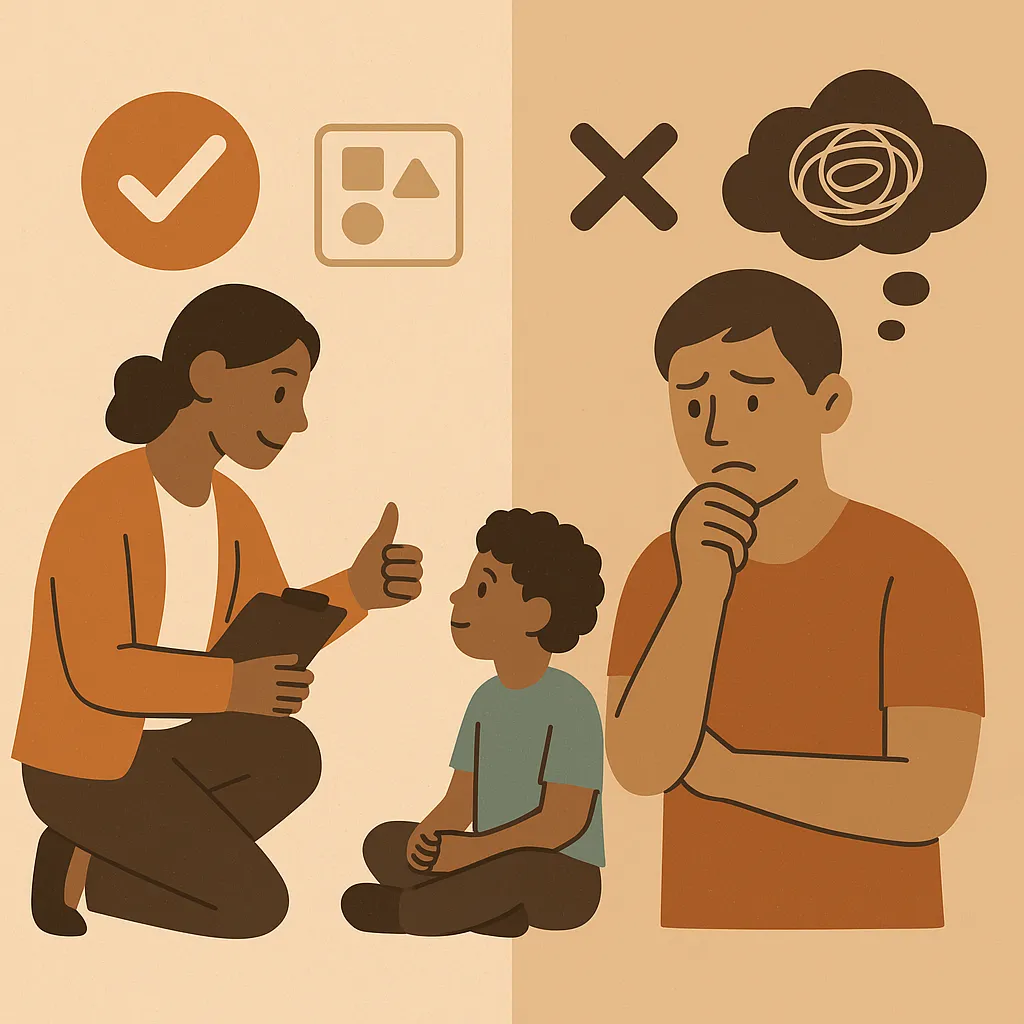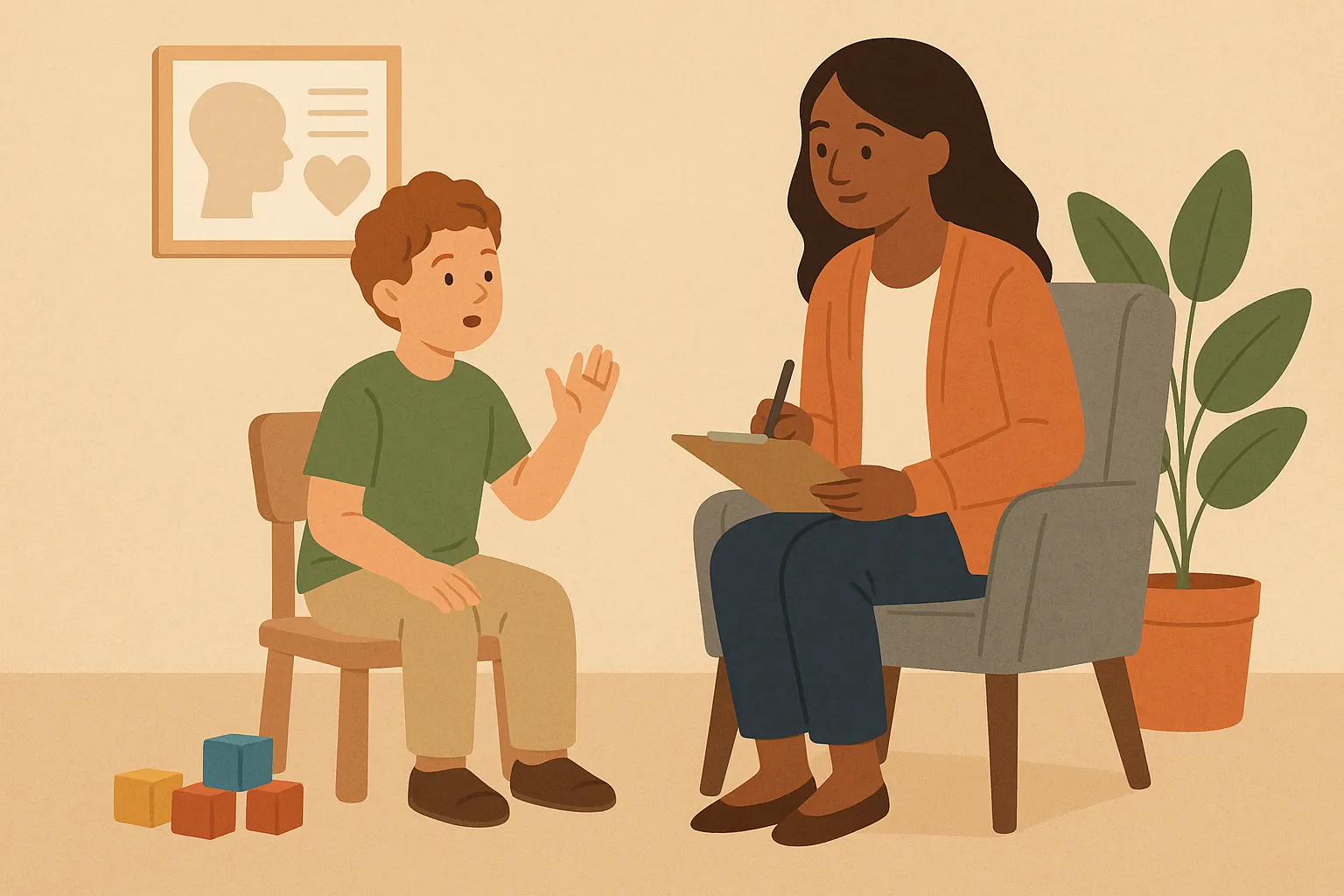Pros and Cons of ABA Therapy

Pros and Cons of ABA Therapy for Autism
Applied Behavior Analysis (ABA) therapy is one of the most common and widely studied interventions for children with autism. It has helped many families see progress in areas like communication, self-help, and learning. Yet others have expressed valid concerns about how it is used, how it feels for their child, and whether it aligns with a neurodiversity-affirming approach.
This article takes a neuroaffirming look at both the potential benefits and the limitations of ABA therapy. The goal is to help parents and caregivers make informed, thoughtful decisions about what may be best for their child.
What Is ABA Therapy and How Does It Work?
ABA therapy is a structured, goal-based therapy focused on understanding how behavior works and using that information to help children learn new skills. The idea is to increase helpful behaviors and reduce those that may interfere with learning, communication, or safety.
ABA programs are designed and overseen by Board Certified Behavior Analysts (BCBAs), with day-to-day sessions typically delivered by Registered Behavior Technicians (RBTs). Therapy often happens one-on-one and includes repetition, visual supports, and reinforcement strategies.
Goals vary depending on the child but often focus on communication, play, daily living routines, and emotional regulation. Some ABA programs also teach parents strategies to use at home for consistency and generalization.
To read more about how ABA therapy is structured, visit What Is ABA Treatment for Autism.
ABA therapy has sparked plenty of conversation within the autism community. While it’s not the right fit for every child, many families still find real value in its structure and support. Here are some of the reasons ABA can be helpful when done thoughtfully and affirmingly.
Pros of ABA Therapy for Autistic Children
ABA therapy has been studied for decades, and many families have seen meaningful progress in communication, independence, and emotional regulation. When designed thoughtfully and delivered ethically, ABA can help children thrive while respecting who they are.
Builds communication and daily living skills
One of ABA’s strengths is its focus on functional communication and real-world skills. Therapists help children express their needs, understand routines, and participate in daily activities.
Communication goals might involve speech, sign language, or AAC (Augmentative and Alternative Communication) devices. A neuroaffirming ABA provider will celebrate all forms of communication equally, focusing on what helps the child feel understood and empowered.
Families often see positive changes when therapy centers on meaningful, self-driven goals rather than conformity.
Provides structure and predictability
Many autistic children benefit from environments that feel consistent and predictable. ABA can offer that structure through clear routines, visual supports, and step-by-step teaching.
Therapists may use visual schedules, social stories, or first/then boards to help children understand transitions. This predictability can reduce stress, increase confidence, and build trust between child and therapist.
Helps reduce unsafe or disruptive behaviors
Instead of labeling behaviors as “good” or “bad,” ethical ABA focuses on understanding the reason a behavior occurs.
A BCBA might analyze what triggers frustration or why a child repeats a certain action. The goal is not to erase behaviors that express need, but to find safer, more effective ways to communicate or self-regulate.
For example, if a child hits when overwhelmed, therapy might introduce coping strategies like requesting a break or using a calm corner.
Encourages independence through skill-building
A neuroaffirming ABA program sees independence as the ability to make choices, communicate needs, and advocate for oneself.
Therapists and families work together to teach skills that support autonomy, such as saying “no,” requesting help, or setting personal boundaries.
When therapy respects the child’s voice, progress becomes not only behavioral but emotional and relational.
Even with its many strengths, ABA isn’t without controversy. The approach has evolved over time, but experiences can vary widely depending on how it’s practiced. Here are some of the concerns to keep in mind when deciding if ABA is the right fit.
Cons of ABA Therapy for Autistic Children
While ABA has helped many families, it is not universally suited to every child. Some approaches have been criticized for being too rigid or compliance-focused. A neuroaffirming perspective invites open discussion about these concerns.
Can feel repetitive or rigid for some children
ABA often uses repetition to reinforce learning. While this consistency helps some children, others may find it repetitive or limiting.
Modern approaches like Naturalistic Developmental Behavioral Interventions (NDBIs) blend structure with play and exploration. These methods allow therapy to feel more natural and enjoyable, while still grounded in evidence-based principles.
It’s important to communicate with the provider if a program ever feels too rigid. Skilled BCBAs should adapt methods and pacing to each child’s comfort and engagement level.
Concerns about masking and compliance
One of the most significant critiques of traditional ABA is that it sometimes emphasizes compliance or “normal” behavior over authentic self-expression.
Some autistic adults have shared that they learned to mask their true selves in order to please adults or appear “typical.” Others describe being encouraged to suppress natural autistic traits, such as stimming or avoiding eye contact, in ways that felt invalidating.
While these practices are less common today, they remain an important part of the conversation. Leading clinicians now emphasize functional skills over appearance, Neuroaffirming ABA focuses on communication, comfort, and connection, not suppression.
Quality and philosophy of programs can vary widely
ABA is a field where quality and ethics matter immensely. Programs differ in supervision, staff training, and clinical oversight. Unfortunately, poorly supervised programs may use outdated methods or set unrealistic expectations.
Families should ask questions like:
- How individualized are the goals?
- How often does the BCBA observe sessions?
- How is data reviewed and shared?
- How are parents included in decisions?
- How does your team incorporate the child’s interests and consent?
- How do you define success in therapy?
- How are emotions and sensory needs addressed during sessions?
Effective ABA feels collaborative and transparent. Parents, caregivers, and therapists should work together as equal partners to support the child’s growth.
High cost and limited accessibility
ABA therapy can be intensive, which makes it costly and sometimes difficult to access. While many states require insurance coverage for autism services, waitlists remain common.
To explore available services, visit Alpaca Health’s family resources page.
Every child’s path is unique, which raises an important question- how can families decide if ABA therapy will truly support their child’s growth and well-being?
Factors to Consider When Deciding on ABA Therapy
Choosing whether ABA therapy is right for your child is a personal decision. Every child has unique strengths, challenges, and learning preferences. The most important factor is whether the approach supports your child’s well-being and respects their individuality.
Here are some key questions to guide your decision:
- Does my child thrive with structure and repetition, or prefer open-ended learning?
- Does the provider prioritize connection, consent, and emotional safety?
- Are goals focused on meaningful, functional outcomes?
- How involved are parents in planning and feedback?
When therapy is built around collaboration and respect, children are more likely to engage, make progress, and feel proud of their growth. The best programs are flexible and individualized. They combine data with empathy, and structure with humanity.
Every family’s journey looks different, but many share the same questions when considering ABA. Below we will take a closer look at a few of them.
FAQs about ABA Therapy
Is ABA therapy neuroaffirming?
It depends on the provider. Many modern clinicians now use neurodiversity-affirming ABA that values each child’s communication style and differences. These approaches move away from “fixing” behaviors and focus instead on helping children thrive as their authentic selves.
Does ABA teach masking?
Older ABA programs sometimes encouraged masking or compliance. Ethical providers today are actively working to change this, centering consent, body autonomy, and emotional well-being.
At what age is ABA most effective?
ABA can begin as early as age two, but it can also support older children and teens. The most important factor is how well the program matches the child’s needs, interests, and developmental level. Neuroaffirming practice also stresses that it’s never too late to learn new coping skills or strategies for independence.
What if ABA doesn’t seem like the right fit?
That’s okay. There are many ways to support an autistic child’s development, including Occupational Therapy, Speech Therapy, and developmental play-based models. A neuroaffirming care team will help you explore what works best for your child, not what’s most traditional.
What is the success rate of ABA therapy?
Success looks different for every child. Studies show that many children make measurable progress in communication, learning, and adaptive skills, but outcomes depend on the quality of the program, the child’s goals, and family participation.
What’s the controversy with ABA therapy?
Concerns come from experiences where therapy felt compliance-based or disregarded the child’s autonomy. Today’s ethical practitioners are working to make ABA more compassionate, flexible, and neurodiversity-affirming.
How Alpaca Health Supports Quality ABA Care
At Alpaca Health, we believe families should have access to high-quality, ethical, and affirming care. We connect parents with a network of independent ABA providers who are BCBA-led, family-focused, and committed to individualized treatment- without the rigid, one-size-fits-all approach.
Our platform helps families simplify care coordination, reduce administrative stress, and focus on what matters most: helping their child thrive in ways that honor their strengths.
Families can choose their own provider, avoid turnover, and work with professionals who align with their values. Each plan is personalized to the child’s needs- without cookie-cutter goals or rigid hour requirements.
Learn more about how Alpaca Health supports families at Alpaca Health Services.
High Quality, Local ABA
If you are ready to partner with a local BCBA and receive the highest quality of care, reach out today!











